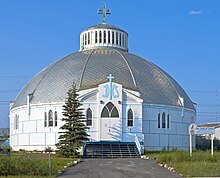Midnight Sun Mosque
In some years Ramadan, with its daily fasts required during the day for a full month, falls during either midnight sun or polar night.
[1] The mosque has a total interior floor space of 144.4 m2 (1,554 sq ft), comprising a prayer hall, library, kitchen, and children's playroom.
[15] Muslims began coming to Inuvik in greater numbers starting in the mid-1970s, as the Arctic oil exploration boom created new job opportunities.
[13] By the 2000s, there were a hundred Muslims in Inuvik, mostly Sunni from Egypt, Lebanon and the Sudan,[16] including all the town's taxi drivers, and many architects, engineers and businessmen.
[10]: 279–80 Beginning in 2000, the local Muslim community was served by a converted 2.7-by-4.3-metre (9 by 14 ft) truck trailer with space for 20 attendees;[15] Eid al-Fitr celebrations were held at the town's curling lounge or its arena.
[19] A painted crescent moon over the entrance was the only outward sign it was a mosque Inside, prayer rows were marked on the carpet with tape.
He advised members to incorporate a non-profit society as a step toward building a formal mosque; they soon founded the Muslim Association of Inuvik.
A member reached out to Saudi-born businessman Hussain Guisti, who had built a mosque for the small Muslim community in the similarly remote northern city of Thompson, Manitoba, while his wife was doing her medical residency there.
On the road leg, a truck took it first to Edmonton, where it would take a route north to Hay River in the Northwest Territories (NWT) for the beginning of the barge trip.
The water route was necessary because several bridges on the upper reaches of the Dempster Highway, the only road to Inuvik, were too narrow for the trucks carrying the mosque.
After the driver took the tires off and used another truck to balance the building, they attempted the crossing, only for that section of the mosque to become unbalanced and threaten to fall off the trailer into the creek.
[20] This caused delays getting to Hay River, where the mosque was scheduled for the last barge of the season—any later and the water levels along the Mackenzie might not be high enough to guarantee passage all the way to Inuvik.
The trip across the lake and down the Mackenzie to Inuvik took ten days, and the mosque reached its destination in late September,[7] greeted by 40 local Muslims, as snow fell for the first time that autumn.
Fathallah Farjat, a Palestinian-born carpenter then working in Hamilton, Ontario, heard about the problem and called Guisti, who paid for his flight to Inuvik.
Farjat worked for six weeks without pay on the mosque's interior, doing framing, hanging drywall, laying carpet, finding space for a kitchen, and designing, then building, the dome and pulpit.
"The day was filled with a lot of emotion", recalled Nilufer Rahman, a Winnipeg documentarian Guisti hired to make a film about the mosque.
"[15] Following the mosque's completion, the Muslim Welfare Centre (MWC) in Toronto provided the funds to purchase an adjacent property to set up the "Arctic Food Bank".
As of 2019 that included 700 families living within two hours' drive of Inuvik; the mosque estimated that at any given time one-quarter to one-third of the immediate residents have used the food bank.
This results in a fast that usually lasts 13 hours out of 24, beginning around 5 a.m. and ending around 6:30 p.m.[3] After a debate early in the mosque's history, the congregation settled on this timetable so that all would eat and pray at the same time.
[4] During Ramadan, the food bank is supplied with qurbani, the lamb, goat and beef meats that prosperous Muslims are required to donate to the needy for Eid al-Adha.
The mosque accepts reindeer or moose, but only if the animal has been killed according to dhabihah requirements: by facing it toward Mecca, cutting its jugular vein and saying "In the name of Allah".
[10]: 288 Amier Suliman, one of the congregants, remarked to an Egyptian news outlet that "this [the mosque] is the first minaret to be erected in the Arctic ... some will say it's a new frontier for Islam.
"[16] The construction and transport of the mosque inspired children's author Shazia Afzal and illustrator Aliya Ghare to co-create the book Journey of the Midnight Sun.
We're already known for the Igloo [Roman Catholic] Church, but now the mosque provides another feature to help us attract quality professionals to move here, bring their families, and become part of the community.

